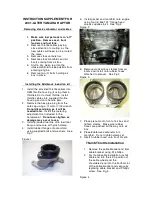
8–31
Customer Information and Reporting Safety Defects
Tire Information (U.S.A.)
WARNING
Always check the tire infl ation pressures on a regular basis according to the
recommended tire infl ation pressure on the tire label and in conjunction with the
information in this owner's manual:
Driving your vehicle with under-infl ated tires is dangerous.
Under-infl ation is the most common cause of failures in any kind of tire and may result
in severe cracking, tread separation or “blowout”, with unexpected loss of vehicle
control and increased risk of injury. Under-infl ation increases sidewall fl exing and
rolling resistance, resulting in heat buildup and internal damage to the tire. It results in
unnecessary tire stress, irregular wear, loss of control and accidents. A tire can lose up to
half of its air pressure and not appear to be fl at!
It is impossible to determine whether or not tires are properly infl ated just by looking at
them.
Checking Tire Pressure
1. When you check the air pressure, make sure the tires are cold —meaning they are not hot
from driving even a mile.
2. Remove the cap from the valve on one tire.
3. Firmly press a tire gauge onto the valve.
4. Add air to achieve recommended air pressure.
5. If you over
¿
ll the tire, release air by pushing on the metal stem in the center of the valve.
Then recheck the pressure with your tire gauge.
6. Replace the valve cap.
7. Repeat with each tire, including the spare.
NOTE
Some spare tires require higher in
À
ation pressure.
8. Visually inspect the tires to make sure there are no nails or other objects embedded that
could poke a hole in the tire and cause an air leak.
9. Check the sidewalls to make sure there are no gouges, cuts, bulges, cracks or other
irregularities.
Mazda3̲8FA4-EA-15G̲Edition2.indb 31
Mazda3̲8FA4-EA-15G̲Edition2.indb 31
2015/07/16 8:47:15
2015/07/16 8:47:15
















































